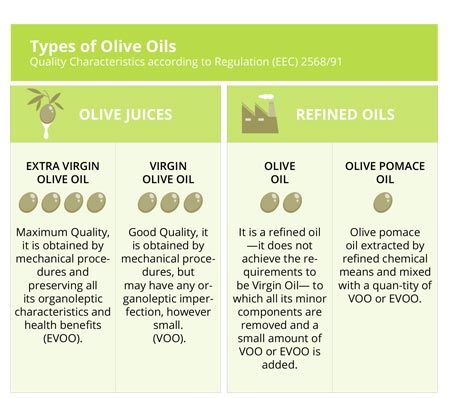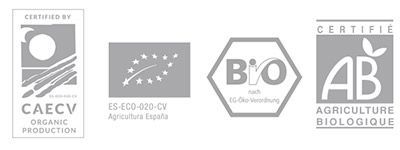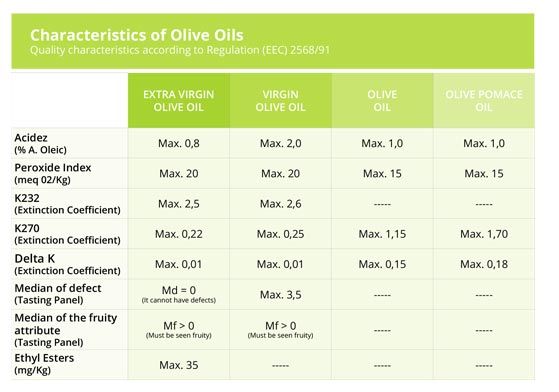Frequent questions
What is EVOO?
They are the initials of Extra Virgin Olive Oil; pure natural olive juice, without composition, aroma or flavor defects and with the best organoleptic properties.
The most characteristic and differential attributes of a good EVOO are its balanced fruitiness, the bitterness and burning naturally present in almost all first class extra virgin olive oils, and especially those that come from greener olives picked up at the beginning of the harvest. The resulting juice has a higher concentration in certain natural compounds such as oleuropein and oleocanthal, directly responsible for its somewhat bitter and burning flavor. These natural antioxidants develop greater or lesser depending on the fruit (type and state of ripeness), but also on the weather and the type of farming…
Every EVOO has a maximum acidity of 0.8%.
What is GREEN Extra Virgin Olive Oil?
The Green Extra Virgin Olive Oil is the one produced at the beginning of the harvest, when the olive is young and healthy, as it could not be otherwise. It is what is popularly known as early harvest olive oil, early EVOO or Premium EVOO. These are the first EVOOs coming mainly from green olives, collected at the beginning of October in the warmest areas (countryside) and between mid and late October in the coldest areas (mountains), such as the GREEN BIO OCTOBRIS. The most important is that the olives are healthy and still green on the outside, although some of them (the least) start turning purple (veraison). The characteristics of this oil is that it is much more fruity and with more intense flavors and smells.
How many types of olive oil are?
This table explains the difference between the different types of Olive Oils according to its quality and typology. Regarding quality, 2 main groups are distinguished: JUICES coming directly from olives and REFINED OILS of which there are different types.
What is organic oil?
Organic Virgin Olive Oil is that olive oil that has been harvested using, exclusively, organic fertilizers, and that the environment of its fields, the handling of the product and its commercialization comply with all regulations on ecological agri-food production of the EU, such as the Ecological Agriculture Committee of the Valencian Community (CAECV), the official entity that has certified all OCTOBRIS BIO products.
Bio, organic and ecological olive oil are they the same? How do I distinguish them at the point of sale?
The denomination of ecological, organic or bio labels (they mean the same thing) are only used in products that have been harvested using, exclusively, organic fertilizers, and that the environment of their fields, the handling of the product and their commercialization comply with the regulations on ecological agri-food production of the EU, such as the Ecological Agriculture Committee of the Valencian Community (CAECV), the official entity that has certified all BIO OCTOBRIS products.
Along with the logos of these control institutions, the labels of organic olive oils —such as the BIO OCTOBRIS line— must show the European logo together with the code of the control institution that certifies it. In addition, the European origin of the product is also showed with the “EU AGRICULTURE” title.
The BIO OCTOBRIS line also has the seals of the French control institutions (AB Seal – Agriculture Biologique) and the German control seal (Bio Siegel).
What is the degree of acidity of an Extra Virgin olive oil?
The degree of acidity of an Extra Virgin Olive Oil is one of the main parameters that are measured in the oil to determine its quality. This level of acidity is determined by the level of fatty acids that the oil has, that is, the degree acidity is directly related to the freshness of the olives with which that oil is made. The fresher they are, the lower the degree of acidity.
Knowing the degree of acidity of an olive oil, in addition to other factors, we can determine if the oil is an extra virgin oil or is not suitable for consumption.
The classification of oil types according to their degree of acidity is as follows:
- Extra Virgin Olive Oil: EVOO cannot have an acidity higher than 0.8º.
- Virgin Olive Oil: The AOV must have a maximum acidity of 2º or less.
- Virgin Olive Oils higher than 2º: These are classified as lampantes and are not suitable for human consumption.
Is EVOO the mildest oil?
No. The natural character of Extra Virgin Olive Oil gives it a certain degree of acidity, but the aroma and flavor are unmistakable. Mild olive oils are usually low-quality industrial productions for mass consumption, since the chemical processes nullify any concentration of natural oleic acid.
Does the quality of an Olive Oil depend on its color?
No. The color that an Extra Virgin Olive Oil has is a consequence of the type and ripeness of the olives with which it is harvested. If the olives have been collected at their optimum point of greening —as in the case of the GREEN OCTOBRIS Extra Virgin Olive Oil, in its Bio and Traditional type— the oil will have a greenish color and a somewhat bitter flavor with spicy touches. On the other hand, if the olives have been harvested fully ripe —as in RIPE OCTOBRIS Extra Virgin Olive Oil—, we will have a more yellowish oil with a milder flavor.
We should also know that the same oil can change color tending to more golden ones, depending on its age and its conservation conditions.
How should I pack and store the oil?
All olive oils expire, both extra virgin and refined oil, as they change over time depending on their exposure to oxygen, light and temperature. For this reason, the best container for extra virgin olive oil is the one that protects it from light (with a container that protects it from light or directly opaque) and its storage must be done in cool environments, away from kitchen’s stove burners.
For this reason, we have choose the Bag in Box packaging in 3,5 and 15 liter formats for our Ripe OCTOBRIS and Ripe BIO OCTOBRIS types.
The Bag in Box is a packaging solution with multiple environmental benefits. Get to know them here.
Why use EVOO for frying?
As for all other uses in the kitchen, extra virgin olive oil is the best option for frying due to its greater stability and resistance to oxidation and high temperatures. In addition, it is the only one that guarantees that its components are all natural and that the fried food will obtain the flavor and nutritional value of the oil.
 English
English Español
Español Deutsch
Deutsch



